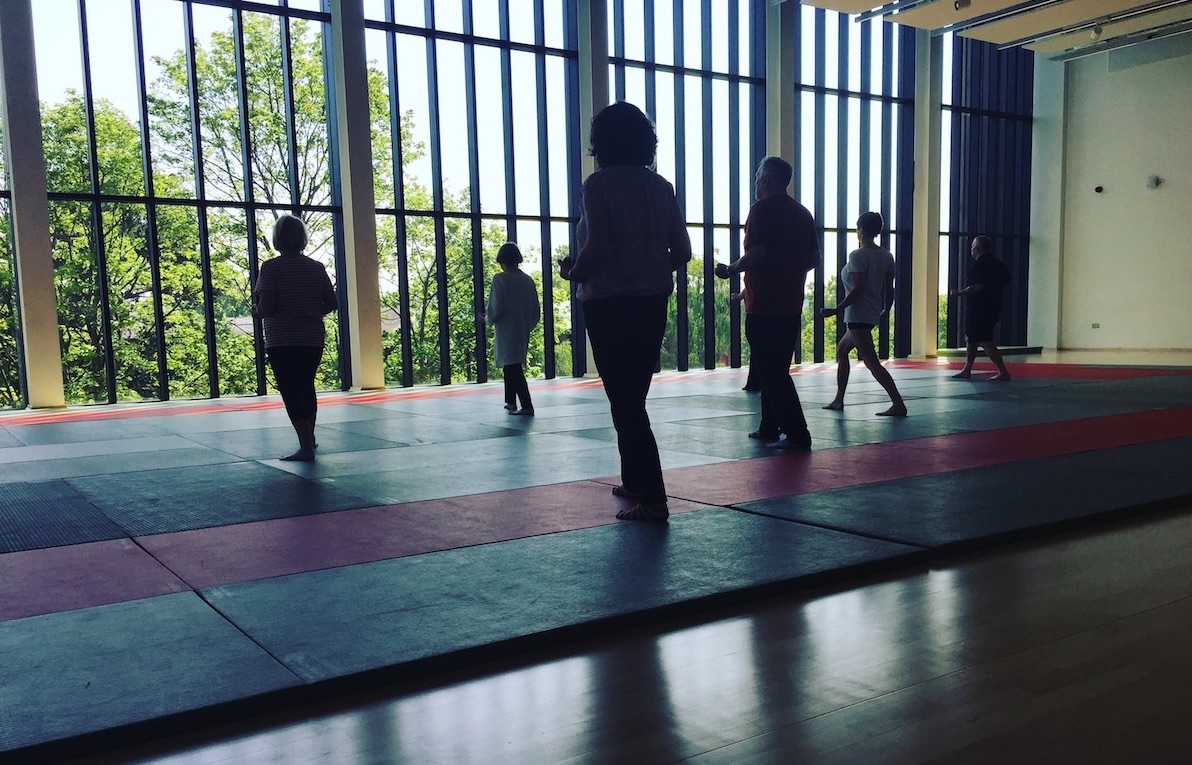It's taken a whole year but I have finally learned all 24 postures of the tai chi 24-form. This feels like a major achievement, after several false starts. Theoretically, I can now also practise at home. Theroretically.
The class
The weekly class lasts an hour and there are about 30 minutes of getting in the right frame of mind before we start practising 'The Form'. The structure of teacher Yang's class is as follows:
- self-massage, patting and stretching
- basic stances and balances
- qi gong exercises with breathing
- make a new friend in the class and practise a qi gong movement together
- practise The Form
- break down a single movement and repeat over and over
- do the form again with new knowledge
- final stretches
- floor relaxation and deep breathing.
The devil is in the detail
Attending every session is key to learning the precise nature of each posture: where the weight sits, are the feet turned in or out, are the hips in line, do you follow your movement with your eyes or look straight ahead, is the fist flat or turned upright, is the foot flat or raised, what is the height of the hand in relation to the body, is the step at an angle or directly ahead/behind…
Missing a class would be like skipping a book chapter. You can pick it up but there is a LOT of minutiae to take on board. Tai chi is a very mental practice as well as a physical one. And this is why I see people (often young students) start and not continue. It is slow and it is slow to learn. You need patience but the reward is that you can take this whole-body exercise with you throughout your life.
Calm mind paradox
If nothing else, tai chi calms the mind. For an hour, stress and anxiety dips or disappears.
The trouble is, a calm mind is needed to practise tai chi well and also to slow the movements right down.
Since I'm a fast person this is a big challenge (I have issues with yoga, too). I think and talk quickly, and can be easily distracted. So, while I'm very happy to have come full circle on my year of learning, I'm still not quite ready to leave the dojo.
I know this because whenever I try tai chi at home my monkey mind is just too busy and involved. I may have finally learnt The Form and can run through it in five minutes, but I still have to think about what move comes next and where my weight should be for balance and how many 'repulse monkeys' there are in the sequence and… well, you get the picture. It's not meditative – yet.
Other barriers
For the 24-form of tai chi (and maybe others – there are other longer forms), you need enough space to practice, such as a garden or park. Unless you have a massive house, of course. The movements involve a fair amount of travelling – I'd guess around 10 metres forwards and back – especially when you start to stretch lower in the postures.
Other barriers are more personal. I think: 'what if the neighbours are looking'? To be fair, I don't care too much what they think, but being watched inhibits how relaxed I am.
Oh and sometimes the rabbits get in the way.
But outdoors tai chi is the best!
How I got started
I started learning tai chi on a free activity session in Cotteridge park (still running) three years ago. I had started a part-sabbatical partly because there was nothing more the physio could do for my chronic neck/shoulder issues so I knew I had to change my work-life balance and help myself.
It was quite peaceful and grounding to be moving outside, as if in sync with nature, swaying like a tree in the breeze or breathing deeply while watching birds circle far overhead.
But it has taken dedicated memorising and attendance to get to the end of a 24-move short form practice.
Initially I went to a local class, which was more of a hilarious social club for retired people. But I really started learning properly at the University of Birmingham's Sport and Fitness centre with a very good teacher who goes over each new posture repeatedly, including the correct breathing, and how it fits into tai chi as a martial art.
Yang really is an excellent teacher and elegant practitioner. As well as learning some of the Chinese names of each move (white crane spreads wings, repulse monkey, grasp the tiger's tail), Yang instilled precise hand positions by adding suggestions that we make a fist as if holding an ice cream, or offering a cake with palm facing up, or sticking a thumb in the pie for a downward thumb position. Food is a popular aide-memoire.
If you want to get an idea of what tai chi 24 form looks like, this 'lady of the pink pyjamas' (as she is known in our class) is a recommended watch.
Tai chi might seem an easy or even elderly option to those who do super-bendy yoga or athletic body pump, but it's one of the hardest things I've done and one of the few exercise regimes that is mental, emotional, whole-body physical and spiritual. The only other one I can think of is bodyboarding/surfing, and living in Birmingham UK tends to put that one out of regular reach.
So, tai chi it is.
